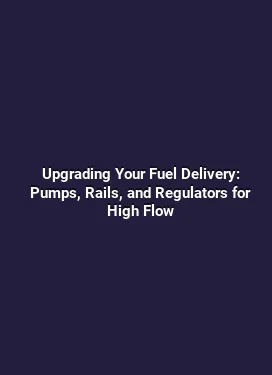Choosing the Right Oil: Decoding Viscosity and Additives for Extreme Performance Engines
Engine performance at the edge of capability hinges on more than just horsepower numbers. The right lubricant strategy—carefully matched viscosity, stable shear properties, and thoughtfully chosen additives—can unlock consistent power delivery, improved reliability, and meaningful protection under demanding conditions. This deep dive examines how viscosity interacts with engine tolerances, how additives shape protection and cleanliness, and practical guidelines for optimizing lubrication in extreme-performance applications.
Understanding Viscosity and Its Impact on Engine Performance

Viscosity measures a fluid’s resistance to flow. In an engine environment, it determines how easily oil coats moving parts, how quickly it returns to film after shear, and how well it maintains a lubricating barrier at high temperatures and high RPMs. The relationship between viscosity and performance is not simply about being thick or thin; it’s about selecting a viscosity range that ensures rapid lubrication startup, full-film protection during peaks in torque, and minimal parasitic drag during steady-state operation.
For extreme-performance engines, viscosity is often described using an SAE grade (for example, 5W-40). The first number refers to flow at cold temperatures, indicating how easily the oil moves when starting a cold engine. The second number reflects viscosity at higher operating temperatures. However, actual performance depends on the oil’s behavior across a wide temperature spectrum and under sustained high shear. A key concept here is viscosity stability under load: some oils maintain their protective film better than others when subjected to high rpm, high boost, or aggressive throttle inputs. This stability is influenced by base oil chemistry, viscosity modifiers, and additive packages.
Beyond simple grade selection, the engine’s tolerances, oil drain strategy, and environmental conditions shape the ideal viscosity window. Modern engines with tighter clearances, high-pressure oil pumps, and aggressive timing strategies demand oils that can quickly establish a robust lubricating film and resist shear-induced thinning. In practical terms, a lubricant chosen for extreme performance should demonstrate predictable film strength across temperature ramps, exhibit low volatility to minimize oil consumption, and retain protective viscosity during rapid transients.
Selecting Base Oils by Viscosity Grades (SAE) and Base Oil Class
Base oils form the foundation of any lubricant and come in different classes, each offering unique response to temperature shifts and shear. For extreme performance applications, the choice often centers on conventional mineral oils versus synthetic options, with synthetics providing superior temperature stability and long-term film strength. When evaluating viscosity grades, consider both cold-start behavior and hot-operating film integrity.
In practice, a higher hot-viscosity grade can provide a thicker lubricating film at peak temperatures, reducing wear in high-load scenarios. However, it can also increase fluid drag and parasitic loss if the engine isn’t configured to handle the extra viscosity. Conversely, a lower cold-start viscosity improves startup reliability and reduces friction during initial crank, but may thin too quickly under sudden zigs in load, compromising film integrity. The balance point often lies in multi-grade formulations that combine a robust base oil with viscosity modifiers to maintain an appropriate viscosity across a broad temperature range.
When engineering for extreme conditions—think high-r RPM, forced induction, or endurance use—the oil’s behavior under shear becomes critical. Shear stability refers to the oil’s ability to resist thinning when subjected to high shear forces inside the pump and bearings. Oils with strong shear stability retain film strength longer, reducing metal-to-metal contact under abrupt throttle changes or sustained high engine speeds. This is particularly important in engines with tighter bearing clearances or advanced variable valve timing strategies where consistent lubrication is essential for reliability.
Engine Additives: Enhancing Protection and Longevity
Additives play a pivotal role in supplementing base oil performance. For extreme-condition engines, the additive package can influence wear protection, deposit control, and cleanliness, which in turn affect power delivery and reliability over time. A well-composed additive system targets three core areas: keeping the engine clean, protecting surfaces under high pressure, and ensuring stable oil pressure and flow characteristics across operating regimes.
Detergents and dispersants help manage sludge and varnish formation, especially under high-temperature operation where residues can break loose and impact clearances or valve train efficiency. Anti-wear and advanced friction modifiers reduce wear on cam lobes, tappets, and timing components, a critical factor for engines operated at high RPM or under increased boost pressures. Finally, antioxidant and anti-oxidation additives protect oil from degradation, maintaining viscosity and film strength over prolonged service intervals. In extreme-performance builds, selecting a robust additive package with proven shear resistance and deposit control becomes essential to protect precision engineering surfaces and to sustain performance levels under load spikes.
Another important category is corrosion and rust inhibitors, which protect internal metal surfaces from moisture and ethanol-rich fuels that can become more prevalent in race or high-performance driving environments. Additionally, seal and compatibility additives can improve gasket longevity and maintain oil seals under cyclic heat loads. The best approach is to match the additive system to the engine’s architecture, fuel type, and the expected operating envelope, rather than applying a generic solution.
Practical Guidelines for Extreme-Performance Engines
To translate theory into practice, start with a targeted viscosity window that aligns with the engine’s tolerances and the expected operating conditions. For engines experiencing sustained high RPM, high boost, or aggressive throttle response, a higher operating-temperature viscosity can help preserve film strength during peak loads. In cooler climates or seasonally variable environments, ensure the cold-start performance remains acceptable to minimize startup wear and to promote rapid oil circulation on cold mornings.
Oil change strategy should reflect the engine’s usage profile. High-load, track-oriented sessions may necessitate more frequent changes or the use of high-performance fluids with enhanced oxidation resistance and improved shear stability. Monitoring oil pressure, temperature, and color trends during service intervals can offer early signals about film integrity and deposit buildup. Practical checks include tracking oil consumption per session, noting any changes in idle stability, and observing any unusual metallic sound or vibration that could indicate lubrication issues.
Another practical consideration is oil temperature management. Even a well-chosen oil can struggle if cooling systems are compromised. Ensure the oil cooler or radiator sizing matches the expected heat load, especially in turbocharged or supercharged configurations. In high-stress scenarios, a slightly higher synthetic fraction can provide more stable viscosity during sustained heat exposure, helping maintain consistent lubrication pressure and film strength when heat soak occurs after hard driving or competition use.
Oil Change Intervals and Monitoring in High-Stress Conditions

In extreme-performance contexts, rudimentary time-based intervals may fall short. A proactive approach combines manufacturer guidelines with real-world data from monitoring sensors and service notes. Tracking parameters such as oil temperature, drive cycle intensity, and oil pressure under load provides a data-driven foundation for maintenance decisions. For engines with variable boost or programmable oil circuits, it’s valuable to log how the oil responds to different duty cycles and throttle inputs, ensuring the lubricant maintains its protective properties across a spectrum of operating states.
Maintaining a clean oil system is equally important. Coking or varnish formation can restrict oil flow paths and hinder the formation of a stable lubricating film. Using an oil with robust deposit control properties helps minimize intake and valve train deposits, supporting maintainable peak performance over time. When evaluating fluids, consider real-world feedback from seasoned racers or high-performance enthusiasts who routinely operate in extreme conditions, as their experiences can illuminate how a fluid behaves under the most demanding scenarios.
Testing and Data Tracking for Peak Performance
Documentation and measurement are powerful tools for optimizing oil choices in extreme applications. Record sensory data from test sessions, including peak oil temperatures, transient pressure spikes, and any abrupt changes in engine response. Compare readings against baseline runs to identify how viscosity and additive performance influence response times, throttle smoothness, and wear indicators. In professional settings, controlled dyno testing and data logging provide the clearest view of how a lubricant behaves under load, enabling precise adjustments to viscosity or additive choices for future builds or track seasons.
Additionally, consider the compatibility of lubricants with existing seals, gaskets, and clearance tolerances. Seal compatibility is especially important when switching between synthetic and conventional oils, or when adopting a different base oil chemistry. In some cases, a staged transition plan—gradually increasing the viscosity or mixing compatible formulations—can mitigate compatibility concerns and help the engine adapt without compromising performance or durability.
The overarching goal is a harmonious balance: a lubricant that retains film strength under peak loads, resists oxidation under sustained high temperatures, and supports clean, efficient operation across the engine’s performance envelope. By aligning viscosity strategy with additive architecture and rigorous monitoring, extreme-performance engines can sustain higher levels of reliability and predictable power delivery over time.






